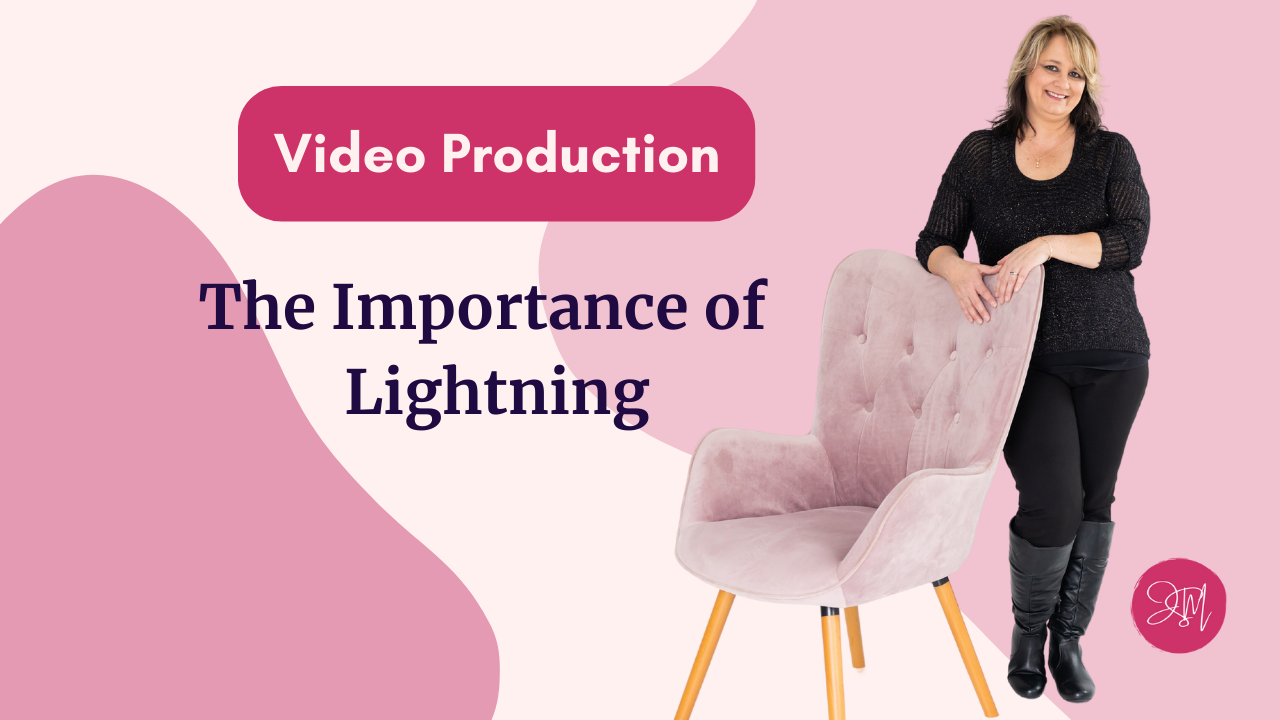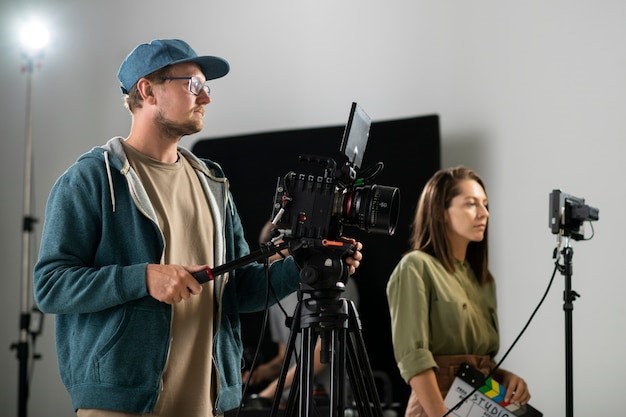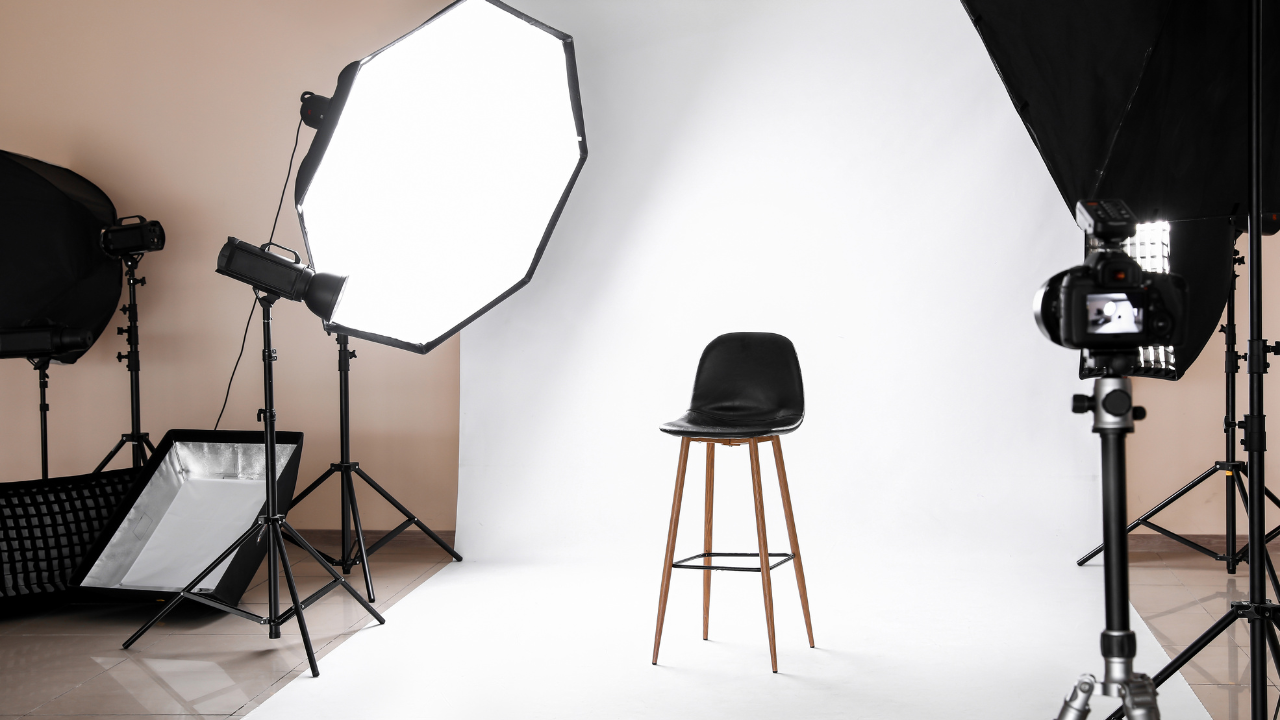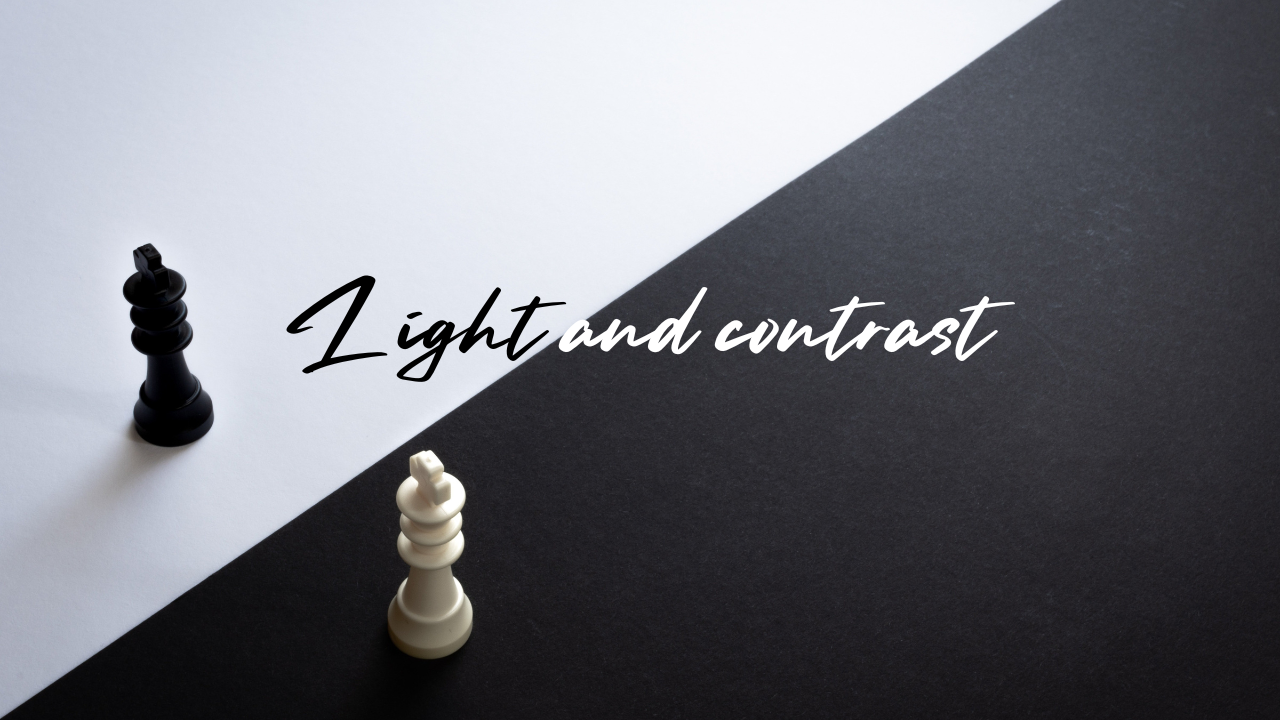Marketing Today
Extra Extra Read all about it!
Put your dreams of running a business into action! Get the inside scoop on how to successfully expand and flourish, whether you're operating locally or digitally. Take charge today with knowledge -- it's all here waiting for you!

The importance of lighting in video production
The Power of Light in video production
Story:
A struggling filmmaker learns the importance of lighting in video production and the impact it can have on the audience through a chance encounter with a lighting expert.
My friend Lucy is a young filmmaker who is struggling to make a name for herself in the industry. Despite her best efforts, her work has yet to receive the recognition she feels it deserves. One day, while scouting a location for her next film, she meets a lighting expert named Neil.

Neil has been in the industry for over 20 years and has worked on some of the most successful films and TV shows of all time. As they talk, Neil explains to Lucy the importance of lighting in video production. He tells her that the way light is used can enhance the mood and tone of a scene, bring out the details, and help communicate a message effectively.
As they work together, Lucy's film starts to take shape, and she realizes that she has finally found her voice as a filmmaker. The film is a success, and Lucy's career takes off.
Years later, Lucy is being interviewed about her latest project, and she credits Neil for teaching her the importance of lighting in video production. She tells the interviewer that without Neil's guidance, she never would have been able to achieve the success she has had. Neil, who happens to be watching the interview, smiles to himself, proud of the impact he has had on Sarah's career.
"Lighting is the key to the whole cinematography. It doesn't matter how good your camera, lenses, or other equipment are. If you don't have the lighting, you don't have the image." - Vilmos Zsigmond, Cinematographer and Guru
The insight of the story:
Lucy is intrigued by Neil's knowledge and passion for lighting and asks if he could help her on her next film. Neil agrees, and Lucy quickly realizes that she has been missing a crucial element in her work. With Neil's guidance, she learns how to use light to create depth, texture, and contrast, and how to manipulate it to evoke emotion in her audience.
The story of Lucy and Neil highlights the crucial role that lighting plays in video production. It shows how, with the right knowledge and guidance. Lucy's success is a testament to the power of lighting and the impact it can have on the audience.
This story serves as a reminder to all filmmakers that lighting is not just a technical aspect of filmmaking but an art form in itself. By paying attention to the lighting, filmmakers can elevate their work to the next level and create a truly immersive experience for their audience.
Additionally, lighting is a fundamental element of video production that should never be overlooked or underestimated. It can make or break a scene, and by using it effectively, filmmakers can create a lasting impact on their audience.
Here are a few statistics that support the importance of lighting in video production:
A study by the Nielsen Norman Group found that viewers of websites and videos spend more time looking at areas of the screen that are well-lit and visually appealing.
In a survey conducted by Animoto, 80% of marketers said that video has directly helped them increase sales, and 92% of marketers said that video is an important part of their marketing strategy.
According to a report by Cisco, video content will make up 82% of all internet traffic by 2022. With so much video content being produced and consumed, it's important to have high-quality visuals, which can only be achieved through proper lighting.
Here are some importance of lighting in video production:

Lighting is an essential component of video production that can make or break the final product's overall quality. The lighting's quality can enhance the mood and tone of a video, bring out the details in a scene, and effectively communicate a message to the audience.
This article will explore the importance of lighting in video production and provide tips for achieving optimal lighting.
The Basics of Lighting Techniques
Understanding the fundamental lighting techniques is essential for achieving optimal lighting in a video. The three-point lighting setup, key lighting, fill lighting, and backlighting are commonly used techniques in video production. These techniques create a balanced, visually appealing scene that is well-lit and easy to see. Color temperature is also an important factor to consider, as it can affect the mood and atmosphere of a scene.
Types of Lighting Equipment
The type of lighting equipment used can significantly impact the final product's quality. There are commonly used in video production. Each has its unique features and advantages, so it's essential to choose the right equipment for your specific needs.
Ring lighting
Daylight Bulbs lighting
LED lighting
Natural lighting
Softboxes and diffusers
Planning the Lighting Setup
Proper planning is essential for achieving optimal lighting in a video. Understanding the location and natural light available, using lighting to convey the mood and tone of the video, and planning camera movements and shot types are all important factors to consider. A well-planned lighting setup can save time, reduce stress, and enhance the final product's quality.
Tips for Achieving Optimal Lighting
There are several tips for achieving optimal lighting in a video. Balancing the light in the scene, avoiding shadows and reflections, using practical lighting, creating contrast for dramatic effect, and experimenting with different lighting setups can all contribute to achieving optimal lighting. These tips can help achieve a high-quality video that is visually appealing and engaging.
Here are a few examples that experimenting with different lighting setups:
A photographer shooting a portrait in a dimly lit room can balance the light in the scene by using a combination of natural light and artificial light sources. They can place the subject near a window to capture soft, diffused light and use a reflector or a fill light to brighten the shadows on the subject's face. This can result in a well-lit portrait with balanced light and minimal shadows.
A filmmaker shooting a scene in a car can avoid reflections by using a polarizing filter on the camera lens. This can reduce the glare and reflections on the car windows and allow the audience to see the actors and the surroundings clearly.
A stage lighting designer can use practical lighting, such as lamps or light fixtures that are already present on the stage, to create a realistic and immersive setting for a play or a musical. For example, they can use warm, yellow light to create the illusion of a cozy living room or cool, blue light to create the atmosphere of a night scene.
Lighting for Different Types of Video Production
Different types of video production require different lighting setups. For example, corporate and promotional videos may require a bright, well-lit scene, while music videos may require a more dramatic, low-lit scene. Understanding the specific needs and requirements of each type of production and adjusting the lighting accordingly is essential for creating a successful video.
Common Lighting Mistakes to Avoid
Several common lighting mistakes can impact the final product's quality. Overexposing or underexposing the subject, using mismatched color temperatures, failing to control shadows and reflections, and ignoring the background are all mistakes to avoid. By avoiding these mistakes, you can ensure that the final product is of high quality and visually appealing.
Back to the story about Lucy and Neil, Lucy is thinking about:
What emotional impact can lighting have on a scene in video production? How can filmmakers effectively manipulate lighting to communicate the desired emotion to the audience?

As Lucy works with Neil, she begins to see the importance of lighting in a whole new light. She learns how to use different types of lighting equipment to achieve the desired effect and how to play with light and contrast to create a dramatic effect. These small details can make a big difference in the final product and can help to bring a scene to life.
The impact of lighting on video production is not limited to the visual experience. As Neil explains to Lucy, lighting can also affect the emotional impact of a scene. For example, a warm, soft light can create a sense of comfort and intimacy, while a harsh, cold light can create a sense of tension or unease. By manipulating the lighting in a scene, filmmakers can effectively communicate the desired emotion to the audience.
As Lucy's career takes off, she continues to use the lessons she learned from Neil in her work. She knows that lighting is a crucial part of the filmmaking process and always pays close attention to this aspect of her work. Her success is a testament to the impact that a chance encounter and a little guidance can have on a person's life and career.
Overall, this story reminds us of the importance of paying attention to every detail in video production, and the role that lighting plays in creating a compelling and immersive experience for the audience.
Why did the cinematographer bring a flashlight to the set?
Because he wanted to lighten up the mood!
In conclusion, lighting is a crucial element of video production that can significantly impact the final product's quality. By understanding the basics of lighting techniques, equipment, and planning, as well as implementing the tips and avoiding common mistakes, you can achieve optimal lighting in your video and effectively communicate your message to your audience. With careful planning and execution, you can create a visually appealing and engaging video that effectively communicates your message to your audience.

The importance of lighting in video production
The Power of Light in video production
Story:
A struggling filmmaker learns the importance of lighting in video production and the impact it can have on the audience through a chance encounter with a lighting expert.
My friend Lucy is a young filmmaker who is struggling to make a name for herself in the industry. Despite her best efforts, her work has yet to receive the recognition she feels it deserves. One day, while scouting a location for her next film, she meets a lighting expert named Neil.

Neil has been in the industry for over 20 years and has worked on some of the most successful films and TV shows of all time. As they talk, Neil explains to Lucy the importance of lighting in video production. He tells her that the way light is used can enhance the mood and tone of a scene, bring out the details, and help communicate a message effectively.
As they work together, Lucy's film starts to take shape, and she realizes that she has finally found her voice as a filmmaker. The film is a success, and Lucy's career takes off.
Years later, Lucy is being interviewed about her latest project, and she credits Neil for teaching her the importance of lighting in video production. She tells the interviewer that without Neil's guidance, she never would have been able to achieve the success she has had. Neil, who happens to be watching the interview, smiles to himself, proud of the impact he has had on Sarah's career.
"Lighting is the key to the whole cinematography. It doesn't matter how good your camera, lenses, or other equipment are. If you don't have the lighting, you don't have the image." - Vilmos Zsigmond, Cinematographer and Guru
The insight of the story:
Lucy is intrigued by Neil's knowledge and passion for lighting and asks if he could help her on her next film. Neil agrees, and Lucy quickly realizes that she has been missing a crucial element in her work. With Neil's guidance, she learns how to use light to create depth, texture, and contrast, and how to manipulate it to evoke emotion in her audience.
The story of Lucy and Neil highlights the crucial role that lighting plays in video production. It shows how, with the right knowledge and guidance. Lucy's success is a testament to the power of lighting and the impact it can have on the audience.
This story serves as a reminder to all filmmakers that lighting is not just a technical aspect of filmmaking but an art form in itself. By paying attention to the lighting, filmmakers can elevate their work to the next level and create a truly immersive experience for their audience.
Additionally, lighting is a fundamental element of video production that should never be overlooked or underestimated. It can make or break a scene, and by using it effectively, filmmakers can create a lasting impact on their audience.
Here are a few statistics that support the importance of lighting in video production:
A study by the Nielsen Norman Group found that viewers of websites and videos spend more time looking at areas of the screen that are well-lit and visually appealing.
In a survey conducted by Animoto, 80% of marketers said that video has directly helped them increase sales, and 92% of marketers said that video is an important part of their marketing strategy.
According to a report by Cisco, video content will make up 82% of all internet traffic by 2022. With so much video content being produced and consumed, it's important to have high-quality visuals, which can only be achieved through proper lighting.
Here are some importance of lighting in video production:

Lighting is an essential component of video production that can make or break the final product's overall quality. The lighting's quality can enhance the mood and tone of a video, bring out the details in a scene, and effectively communicate a message to the audience.
This article will explore the importance of lighting in video production and provide tips for achieving optimal lighting.
The Basics of Lighting Techniques
Understanding the fundamental lighting techniques is essential for achieving optimal lighting in a video. The three-point lighting setup, key lighting, fill lighting, and backlighting are commonly used techniques in video production. These techniques create a balanced, visually appealing scene that is well-lit and easy to see. Color temperature is also an important factor to consider, as it can affect the mood and atmosphere of a scene.
Types of Lighting Equipment
The type of lighting equipment used can significantly impact the final product's quality. There are commonly used in video production. Each has its unique features and advantages, so it's essential to choose the right equipment for your specific needs.
Ring lighting
Daylight Bulbs lighting
LED lighting
Natural lighting
Softboxes and diffusers
Planning the Lighting Setup
Proper planning is essential for achieving optimal lighting in a video. Understanding the location and natural light available, using lighting to convey the mood and tone of the video, and planning camera movements and shot types are all important factors to consider. A well-planned lighting setup can save time, reduce stress, and enhance the final product's quality.
Tips for Achieving Optimal Lighting
There are several tips for achieving optimal lighting in a video. Balancing the light in the scene, avoiding shadows and reflections, using practical lighting, creating contrast for dramatic effect, and experimenting with different lighting setups can all contribute to achieving optimal lighting. These tips can help achieve a high-quality video that is visually appealing and engaging.
Here are a few examples that experimenting with different lighting setups:
A photographer shooting a portrait in a dimly lit room can balance the light in the scene by using a combination of natural light and artificial light sources. They can place the subject near a window to capture soft, diffused light and use a reflector or a fill light to brighten the shadows on the subject's face. This can result in a well-lit portrait with balanced light and minimal shadows.
A filmmaker shooting a scene in a car can avoid reflections by using a polarizing filter on the camera lens. This can reduce the glare and reflections on the car windows and allow the audience to see the actors and the surroundings clearly.
A stage lighting designer can use practical lighting, such as lamps or light fixtures that are already present on the stage, to create a realistic and immersive setting for a play or a musical. For example, they can use warm, yellow light to create the illusion of a cozy living room or cool, blue light to create the atmosphere of a night scene.
Lighting for Different Types of Video Production
Different types of video production require different lighting setups. For example, corporate and promotional videos may require a bright, well-lit scene, while music videos may require a more dramatic, low-lit scene. Understanding the specific needs and requirements of each type of production and adjusting the lighting accordingly is essential for creating a successful video.
Common Lighting Mistakes to Avoid
Several common lighting mistakes can impact the final product's quality. Overexposing or underexposing the subject, using mismatched color temperatures, failing to control shadows and reflections, and ignoring the background are all mistakes to avoid. By avoiding these mistakes, you can ensure that the final product is of high quality and visually appealing.
Back to the story about Lucy and Neil, Lucy is thinking about:
What emotional impact can lighting have on a scene in video production? How can filmmakers effectively manipulate lighting to communicate the desired emotion to the audience?

As Lucy works with Neil, she begins to see the importance of lighting in a whole new light. She learns how to use different types of lighting equipment to achieve the desired effect and how to play with light and contrast to create a dramatic effect. These small details can make a big difference in the final product and can help to bring a scene to life.
The impact of lighting on video production is not limited to the visual experience. As Neil explains to Lucy, lighting can also affect the emotional impact of a scene. For example, a warm, soft light can create a sense of comfort and intimacy, while a harsh, cold light can create a sense of tension or unease. By manipulating the lighting in a scene, filmmakers can effectively communicate the desired emotion to the audience.
As Lucy's career takes off, she continues to use the lessons she learned from Neil in her work. She knows that lighting is a crucial part of the filmmaking process and always pays close attention to this aspect of her work. Her success is a testament to the impact that a chance encounter and a little guidance can have on a person's life and career.
Overall, this story reminds us of the importance of paying attention to every detail in video production, and the role that lighting plays in creating a compelling and immersive experience for the audience.
Why did the cinematographer bring a flashlight to the set?
Because he wanted to lighten up the mood!
In conclusion, lighting is a crucial element of video production that can significantly impact the final product's quality. By understanding the basics of lighting techniques, equipment, and planning, as well as implementing the tips and avoiding common mistakes, you can achieve optimal lighting in your video and effectively communicate your message to your audience. With careful planning and execution, you can create a visually appealing and engaging video that effectively communicates your message to your audience.

